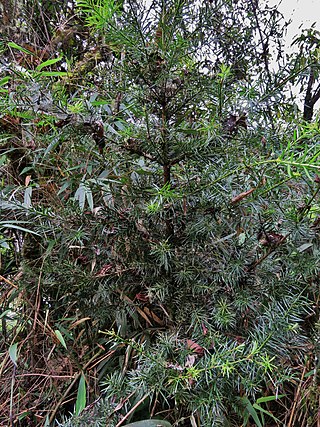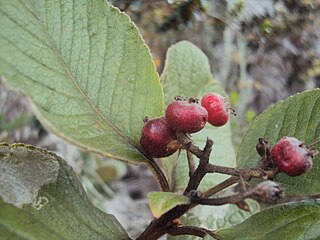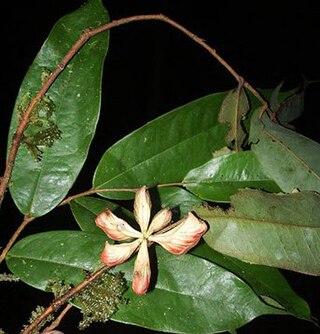
Rosaceae, the rose family, is a medium-sized family of flowering plants that includes 4,828 known species in 91 genera.

Prunus serotina, commonly called black cherry, wild black cherry, rum cherry, or mountain black cherry, is a deciduous tree or shrub of the genus Prunus. Despite being called black cherry, it is not very closely related to the commonly cultivated cherries such as sweet cherry, sour cherry and Japanese flowering cherries which belong to Prunus subg. Cerasus. Instead, P. serotina belongs to Prunus subg. Padus, a subgenus also including Eurasian bird cherry and chokecherry. The species is widespread and common in North America and South America.

Grias is a genus of flowering plants in the family Lecythidaceae, described by Linnaeus in 1759. It is native to northwestern South America, Central America, and Jamaica.

Dipteryx charapilla is a little-known species of flowering plant in the family Fabaceae, a large to mid-sized tree growing along rivers in the rainforests of Brazil. and Peru.

Podocarpus glomeratus is a species of conifer tree in the family Podocarpaceae. It is native to the montane rainforests of Bolivia, Ecuador, and Peru; between 1800–3600 meters above sea level.

Prunus mexicana, commonly known as the Mexican plum, Inch plum, and Bigtree plum, is a North American species of plum tree that can be found in the central United States and Northern Mexico.
Triniochloa is a genus of Latin American plants in the grass family.
Apodanthera herrerae, known as ckoto-ckoto, is grown for its edible tuber. It originates in the Andes.
Callaeum antifebrile is a South American jungle vine of the family Malpighiaceae which occurs predominantly throughout the Upper Amazon basin, and less frequently along the Lower Amazon. Occasionally a component in ayahuasca decoctions, it is used as a folk medicine in some parts of Brazil, often as an antifebrile (anti-fever) remedy.
Prunus gentryi is a species of wild cherry in the genus Prunus, family Rosaceae, native to the Mexican states of Chihuahua and Sonora. It grows along streambanks in mountainous regions of the Sierra Madre Occidental. The scientific description was published in 1937.

Hippeastrum pardinum is a flowering perennial herbaceous bulbous plant, in the family Amaryllidaceae, from Peru to Bolivia. Originally collected in 1866 by Richard Pearce, it was used in breeding programmes.

Eustephia is a genus of South American plants in the Amaryllis family. All 6 known species are native to Peru, with the range of one species extending also into Bolivia.
Spermacoce glabra, smooth false buttonweed, is a New World species of plants in the coffee family.
Berberis weberbaueri is a shrub in the Berberidaceae described as a species in 1908. It is endemic to Peru, found in the regions of Ancash, Cajamarca, La Libertad, and Lambayeque.

Gunnera magellanica is a perennial rhizomatous dioeceous herb native to Chile, Argentina and the Falkland Islands, and Andean areas of Peru, Ecuador. In the southern part of its range it grows in damper parts of the Magellanic subpolar forests and Valdivian temperate forests, and shrub formations on Tierra del Fuego, with an altitudinal range from sea level to 1500m.
Prunus huantensis is a South American tree native to mountain forests of Peru, Ecuador, and Colombia. It may be a synonym of Prunus brittoniana.

Hesperomeles ferruginea is an evergreen shrub or tree in the family Rosaceae, native to montane forests on the Andes from Venezuela to Bolivia.
Fusaea peruviana is a species of plant in the family Annonaceae. It is native to Brazil, Colombia, Ecuador and Peru. Robert Elias Fries, the Swedish botanist who first formally described the species, named it after Peru where the specimen he examined was found near the Huallaga River and the city of Yurimaguas.

Dipteryx micrantha is a tropical flowering plant, a giant tree in the Faboideae subfamily of the bean family Fabaceae. It is a dominant emergent tree in parts of the rainforests of Bolivia, Brazil, Colombia, Ecuador and Peru. In the international timber market, this species is traded under the name cumaru. It furnishes a dense, hard, beautiful reddish timber which has become a popular import in the 2010s for use in parquet. The ornamental bunches of lilac pink flowers high in the canopy eventually develop into a mass of large fruit pods, which are an important food for many native animals during the dry season. The fruit contains a single oily seed which is edible, although these seeds are not exploited as a commercial product.

Xylopia cuspidata is a species of plant in the Annonaceae family. It is native to Bolivia, Brazil, Colombia, Ecuador and Peru. Ludwig Diels, the botanist who first formally described the species, named it after the leaves which have an abruptly pointed tip.











